 Crop & Field Notes: What’s in the Fields – July 2013
Crop & Field Notes: What’s in the Fields – July 2013
Summer is upon us, and crops like our dry-farmed tomatoes are on the verge of being ready for harvest. Check out all that is going on in the fields.

This dry-farmed tomato field is looking very different from when it had a cover crop in March (below).
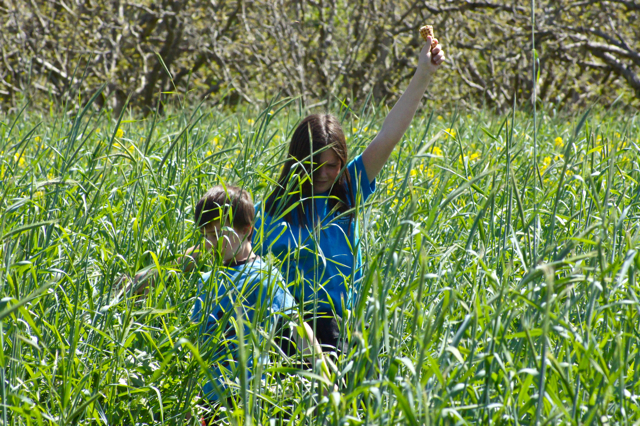
The cover crop was tall enough to get lost in during our Sheep to Shawl Event. Hold that ice cream cone high!
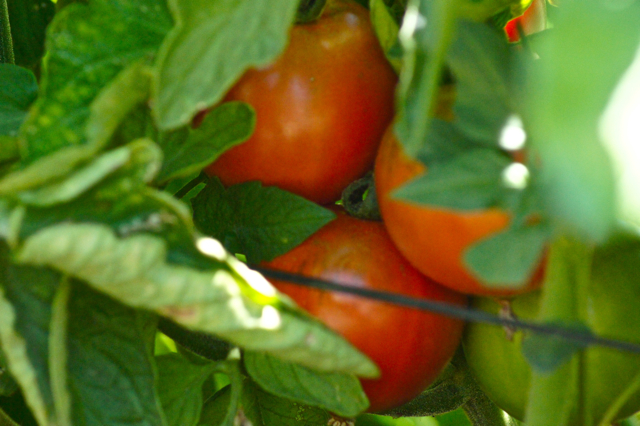
The very first ripe dry-farmed tomatoes can be found hidden among the lower leaves and branches.

Most of the tomatoes are still green though, or just starting to turn red.

There is quite a difference between these March fields and the July ones, below.

The raspberries (on the left) are green again, and the cover crops are gone – replaced by summer squash, kale, leeks, and chard.

The chard in this week’s boxes is most likely from the rows in the foreground, while the leeks in the back rows will be in future boxes.
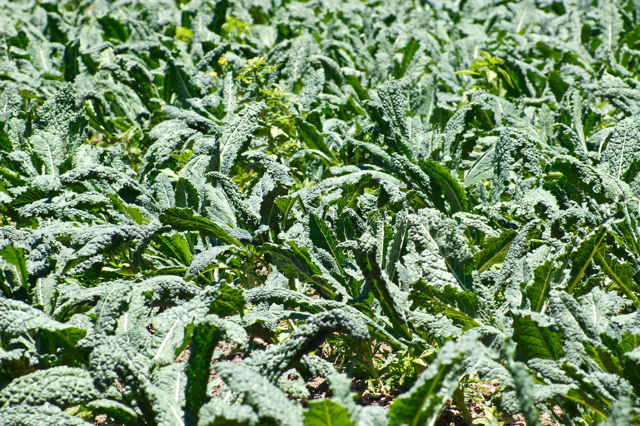
Dino Kale anyone? This crop is looking gorgeous!

Field of young summer squash.
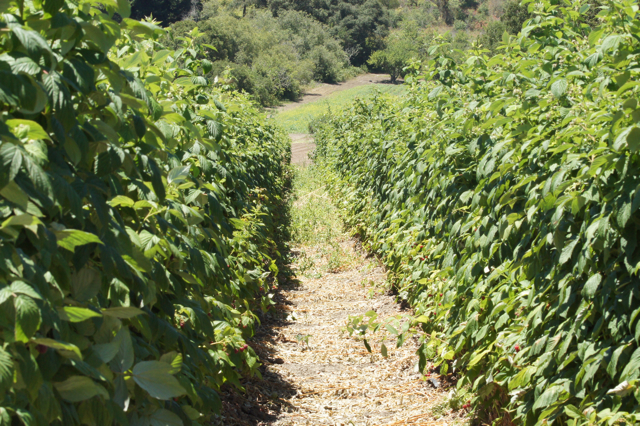
View from within the raspberry rows. You can’t see them, but the bees are busy buzzing among the raspberry blossoms.
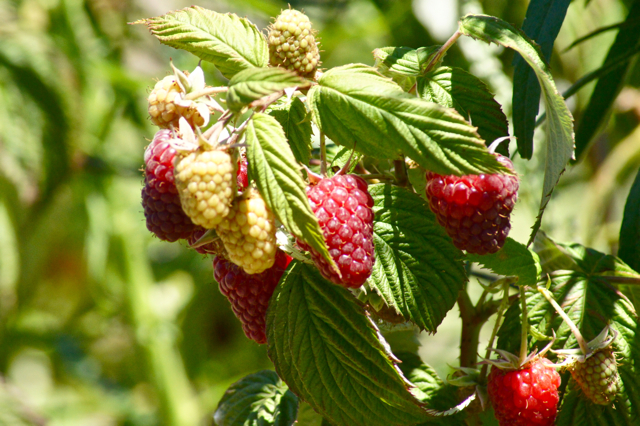
The raspberries are soooo gooooood!

And the blackberries are coming on strong, too.
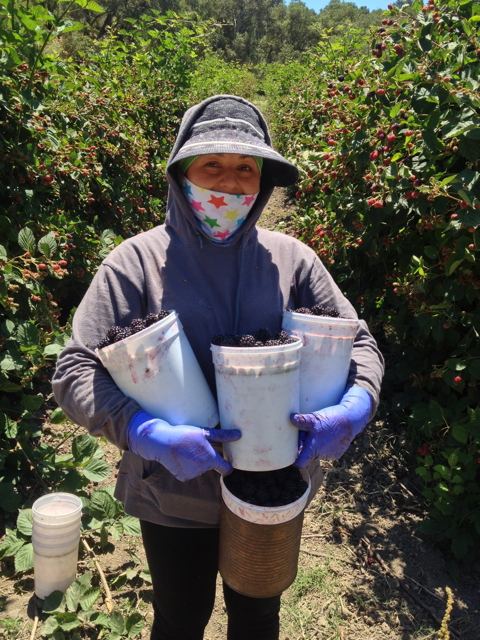
Here’s Adrianna with just the start of today’s blackberry harvest.
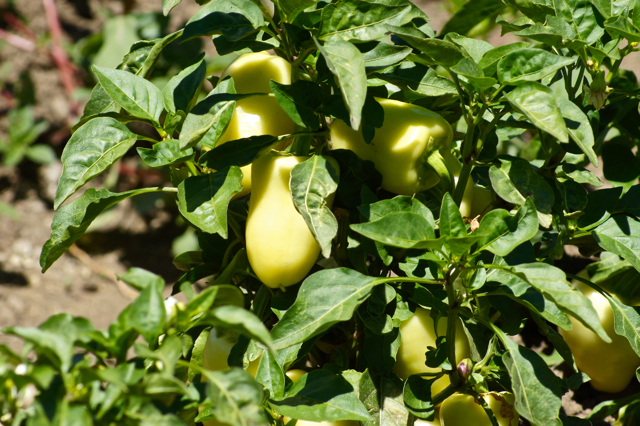
These yellow peppers….

… and these poblano peppers …

… and all this basil, are loving the heat we’ve been getting so far this season. Everything is ripening about two weeks earlier than last season.
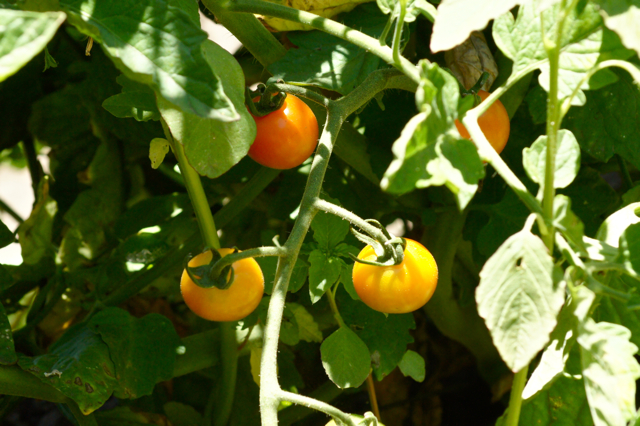
And we can’t forget about the cherry tomatoes. The first, small harvest is going to the Farmers Markets this week. They’ll be in the shares soon, too!

Nearly six hundred apple trees were grafted earlier this year. This one was grafted in February.
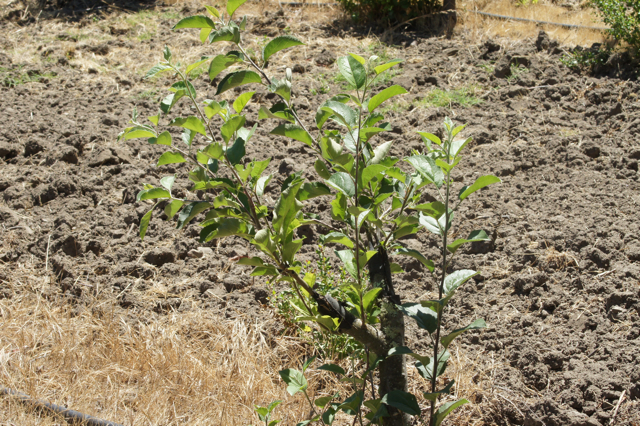
Now it’s leafing out, and will be producing apples in future seasons.

Here are some fujis ripening in a more mature orchard. They’ll be ready for harvest sometime in October.

Warren Pears, which will also be ready for harvest in October or November, can now be spotted on the trees.
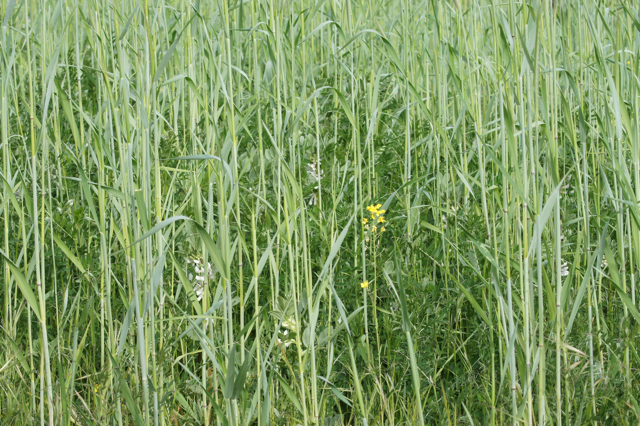
The cover crops in the upper fields (where Tom and Elisa played back in April) are now gone, replaced with…

… this corn field.
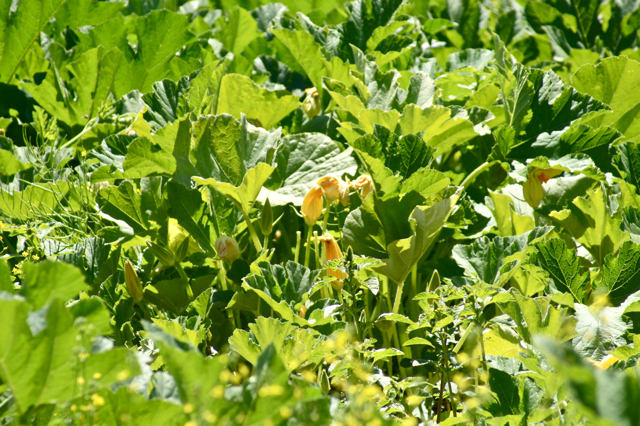
And last but not least, blossoms can be spotted in our pumpkin patch. Is it too early to mention Halloween?
 Springtime Blooms on the Farm – March 2013
Springtime Blooms on the Farm – March 2013
Although the infamous Food Drought occurs during March, there’s still a lot happening in the orchards and fields. Here are some pictures of the various things that are in Spring bloom for you to enjoy. (Originally posted in March 2013)

The apricot trees are a riot of blossoms exploding like popcorn right now. Though we need more rain, keep your fingers crossed it holds off long enough for proper pollination and fruit set to happen.

We dream of a bumper crop of ‘cots this season since we haven’t had one in years.
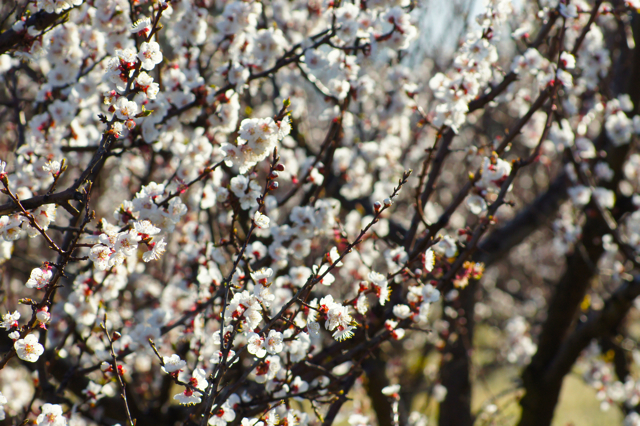
Apricots are self pollinating, which is why you won’t see many bees buzzing from blossom to blossom. The blossoms smell amazing though, and if we could, we’d add a scratch ‘n sniff to the picture for you.
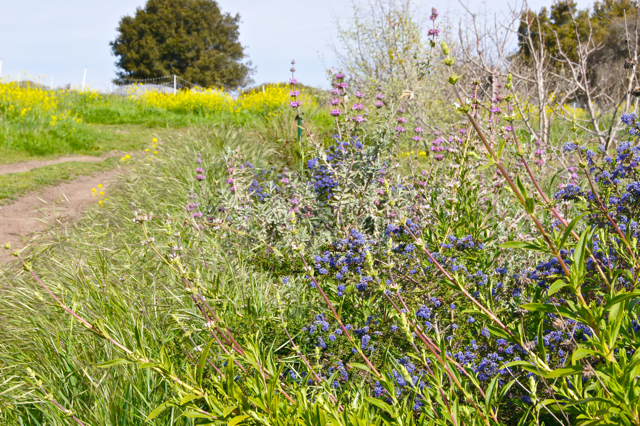
This is one of the many hedgerows planted on the Farm as part of a partnership with Wild Farm Alliance. This hedgerow contains ceanothus (California Lilac) and sage, among other native plants. There is a self-guided tour you can take that highlights more of these projects around the Farm.
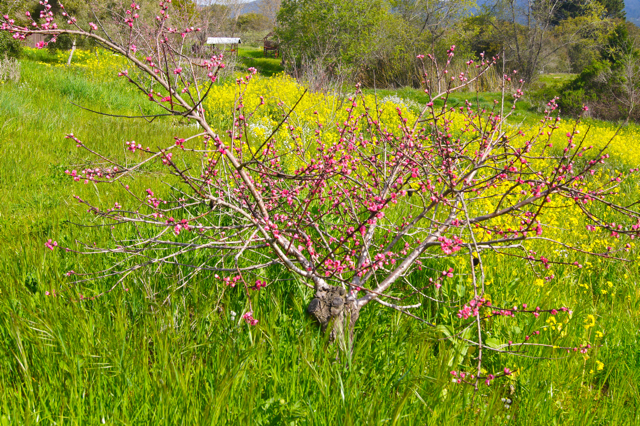
This beauty is one of the few peach trees on the Farm. We have few stone fruit trees since our coastal climate is too moderate for them to grow and produce well. They do much better in the inland valleys, like the San Joaquin, which get colder during the winter.
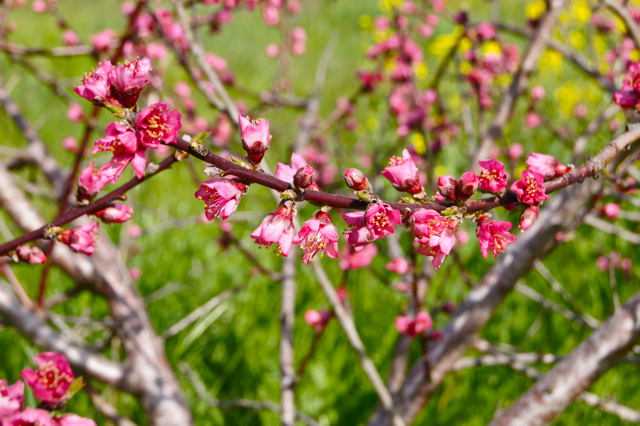
So close you can reach out and touch them.

The yellow of mustard blossoms is a common sight in the cover crops we plant to recharge the soil and control erosion during the winter. Here it is competing with rye.
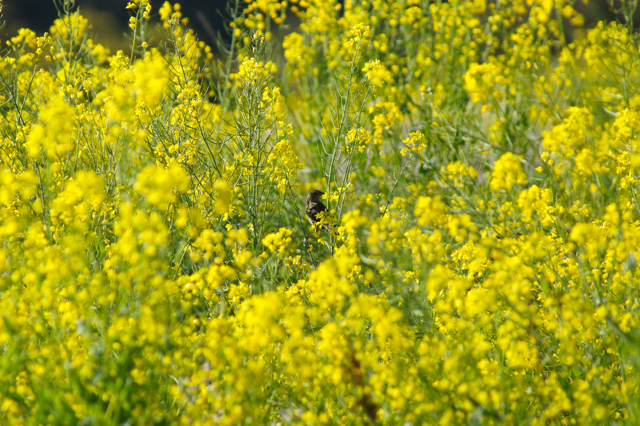
Mustard also provides cover and food for song birds during the winter. You may only see just the one, but you can be sure there are a dozen more hidden in there. They flutter and pop up like Jack in the Boxes as you walk past the fields.

Mustard, originally planted among apple trees that were removed (you can see some of the remaining ones at the top of the picture), has taken over this sloping field where we grew dry-farmed tomatoes during the last Regular Season. Mmmm … dry-farmed tomatoes. Is it August yet?
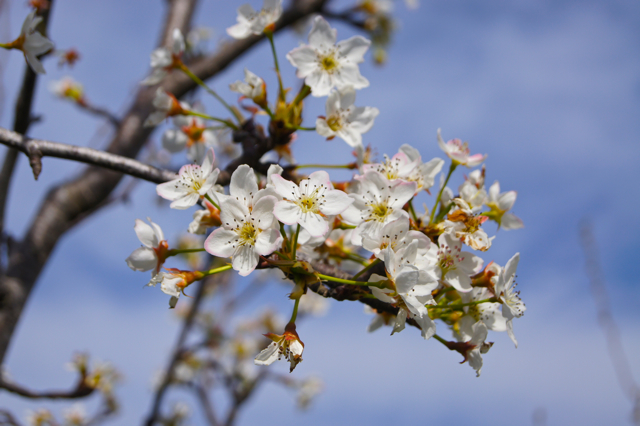
These are blossoms of an early blooming variety of pear tree. The trees that produce the Warren (French Butter) Pears that go in the shares have yet to bloom.
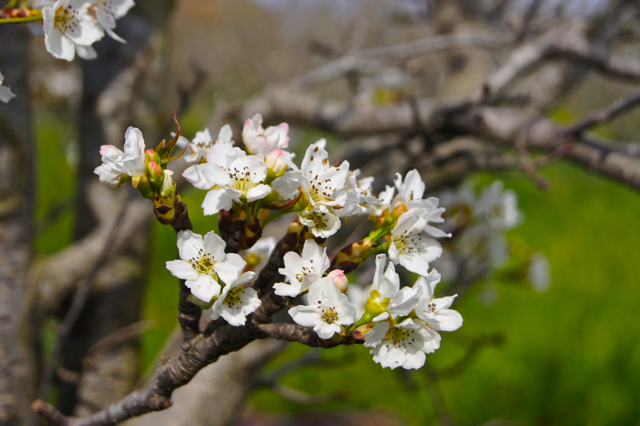
While pear blossoms look a lot like plum blossoms, there are differences. Notice the blush of pink at the tips of some of the petals and how dark the pollen is. Now, check out the plum blossoms in the next picture.

See how there’s no pink on the petals of these plum blossoms? The pollen is also yellow, rather than brown like on the pear blossoms above.
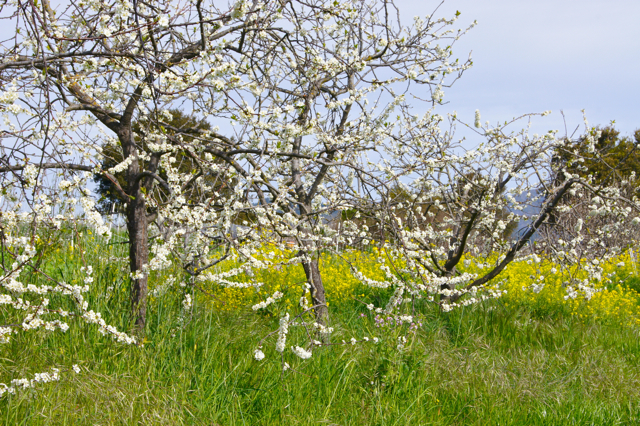
Plum trees have different growing patterns. Notice how the branches and trunks of these trees swoop around in curves.
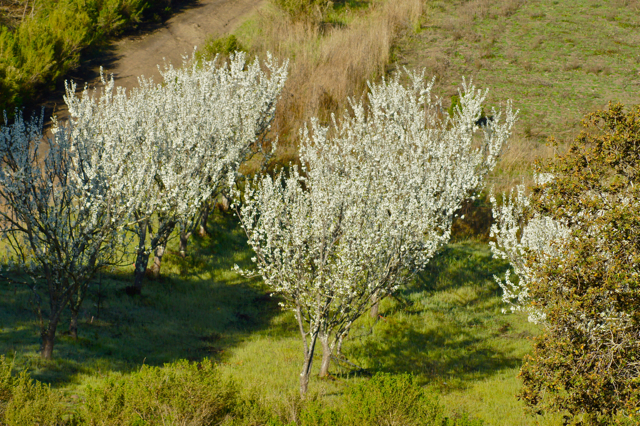
While these plum trees send their branches shooting mostly straight upwards.
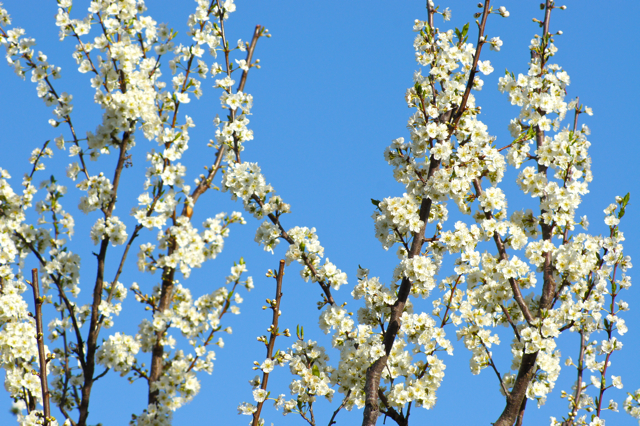
If you look closely, you can spot the places where the branches of this plum tree were pruned just a few weeks ago.
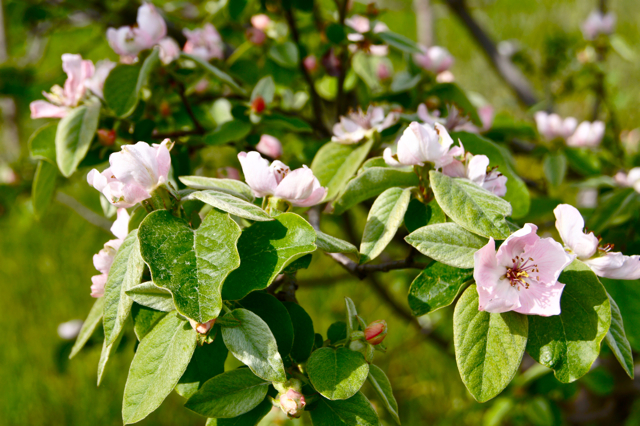
Quince trees make good root stock for pear trees to be grafted to, and that’s what these trees were originally planted for. Farmer Tom became fond of them, though, and decided to leave them as is. We’re so glad he did, because otherwise we wouldn’t have the quince candy (membrillo) their fruit gets turned into for us by Happy Girl Kitchen. This quince orchard is near Toasty 2, our cob oven that’s used during Community Farm Days to make things like pizza and apple tarts. Did someone just say, “Yum!”?
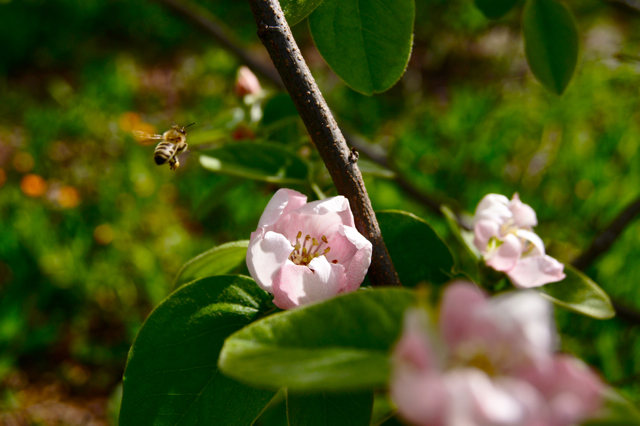
Unlike apricots, quince are not self pollinating, so it’s a good thing the bees love them. Here’s one coming in for a landing now.
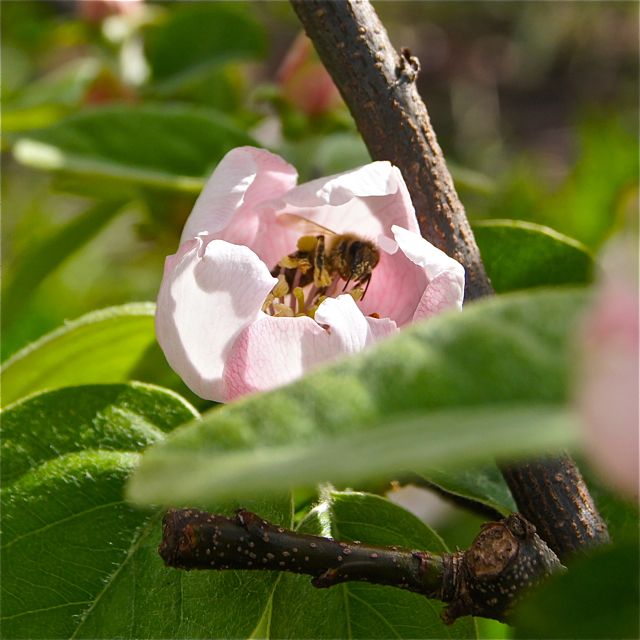
It’s great how the quince blossom acts like a cup to keep the bee inside as long as possible to ensure good pollination.
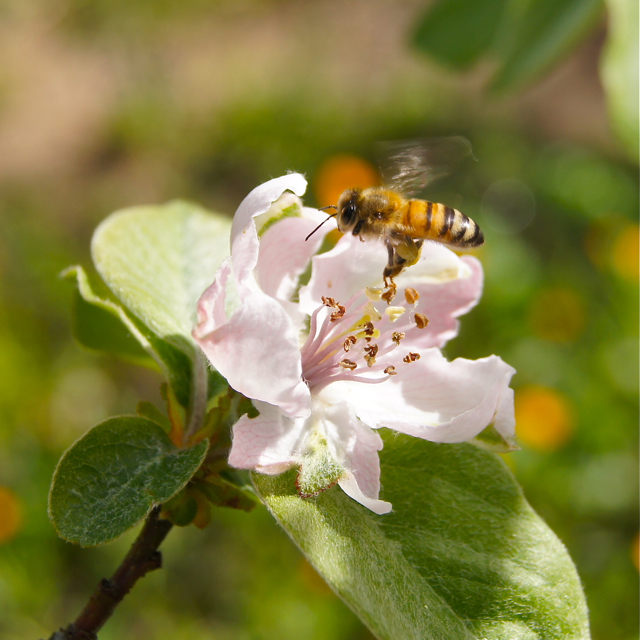
Notice the “peach fuzz” on the leaf below the blossom. This same fuzz covers the quince fruit itself which is pear shaped, so imagine a fuzzy pear and you’ll have a good idea of what’s to come after this bee does her job.
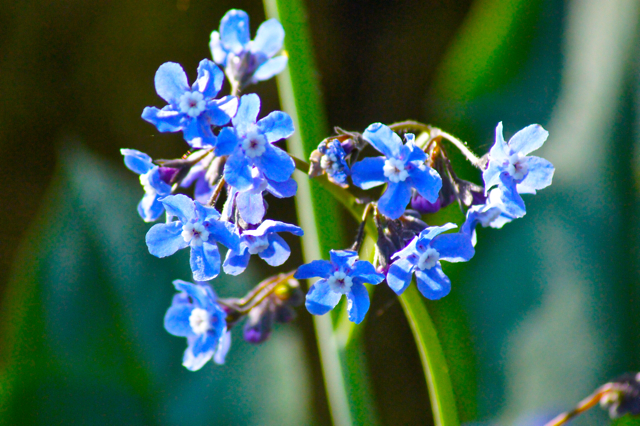
At the very back of the Farm is a short wild-land trail where native wild flowers like this Western Hound’s Tongue can be found growing under oak trees near groves of redwoods.
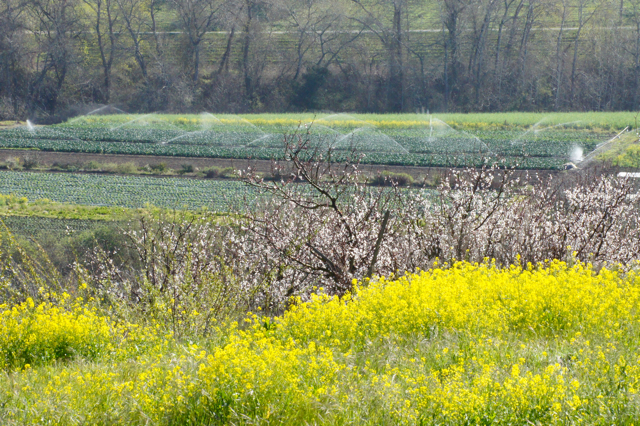
This picture captures a patch of mustard in front of one of our apricot orchards on a hillside above the lower fields where we are growing veggies that will soon be in your share box.
Community Supported Agriculture, whether receiving a share or going to a Farmers Market, is the best way to ensure a farm like ours thrives and continues to provide a place for natural organic diversity.
 A Look Back Over the Year – Jan 2013
A Look Back Over the Year – Jan 2013
Participating in the Farm’s CSA program and receiving a weekly share gives us the chance to experience the seasonal nature of the harvest over the course of the year. Participating from year to year provides an even broader perspective of how nature changes the harvest from one year to another.
Here’s a look at what 2013 was like (click on highlighted text to reach an associated post) –
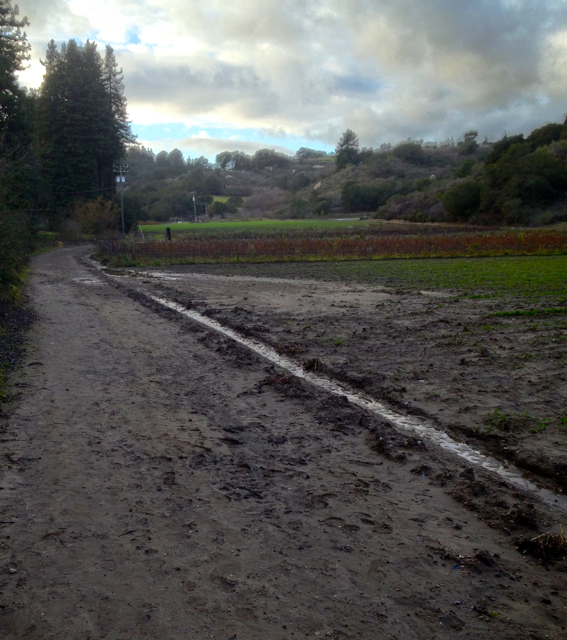
Unlike the lack of rain we are currently experiencing, last year began with storms which flooded part of our Lower Fields. By chance, the flooded area was in part of the fields planted mostly with cover crop.

Though there are apples from the previous Fall harvest in cold storage, January is the time when the trees themselves are dormant. This is when the trees were pruned in preparation for their next crop.
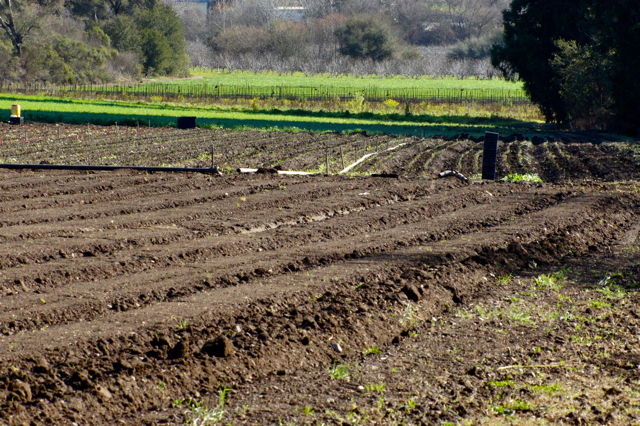
As the fields became dry enough, rows could be formed for new plantings. The green of cover crops just sprouting can be seen in the background, while the field in the mid-ground is full of transplants, and is pictured in other posts in July, August, and December.

Planted at the end of the previous year, cover crops go through their own progression. Pictured here are February cover crops in the Upper Fields. The mustard just beginning to bloom, while the rye and legumes have yet to reach full height.
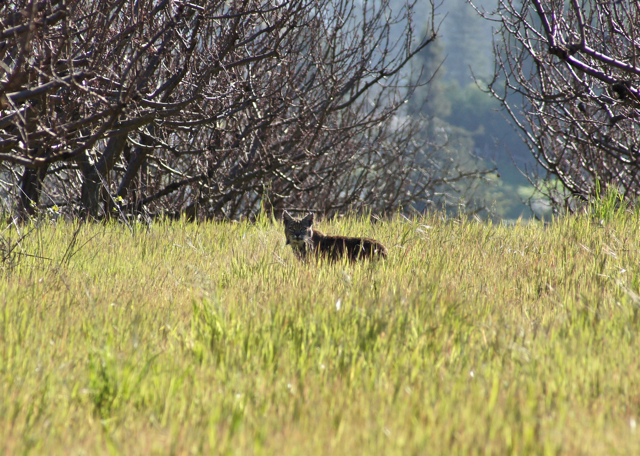
While cover crops are planted in the fields, the orchards have their own carpet of grasses in February which are just tall enough for a bobcat to hide in.
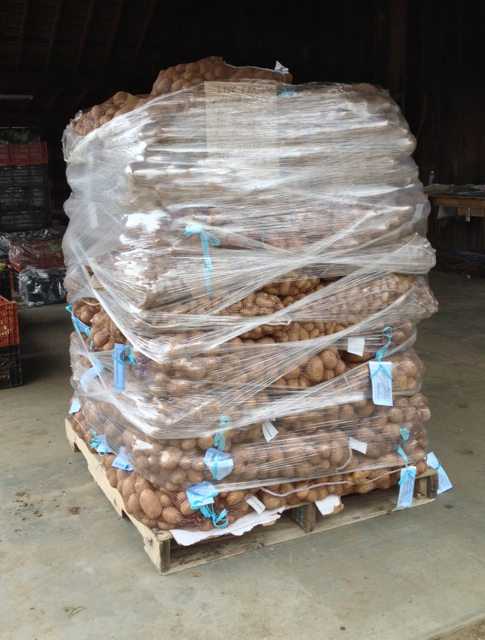
Preparations for crops that will be harvested during the upcoming Main Season are made in February. These seed potatoes arrived in mid-February.

Dormant since November, late February is when the apricot trees begin to bloom as well. Beginning as tiny buds, it only took a couple of weeks until the blossoms burst forth (below).

By mid-March the apricots were in full bloom. And they weren’t the only thing blooming on the Farm.

The fields themselves can change very rapidly. These are the Lower Fields in mid-March; the rows that were bare dirt in mid-February now covered in seedlings.

And here are the same fields less than three weeks later. Notice how much the crops grew with the returning sunlight and warmth as Spring arrived.
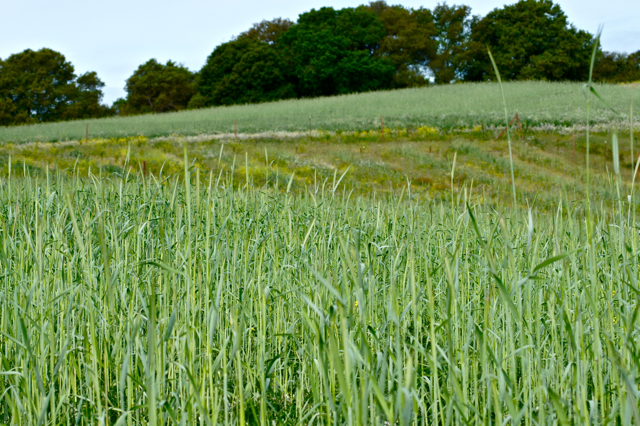
These are the same cover crops pictured above. It’s the end of March now, and you can see how the rye overtook the mustard. The cover crops stayed in the fields another couple of weeks. Long enough for Tom and Elisa to have some fun in them.

During the last half of March, the apricots went from bearing just blossoms to having a mix of blossoms and leaves.
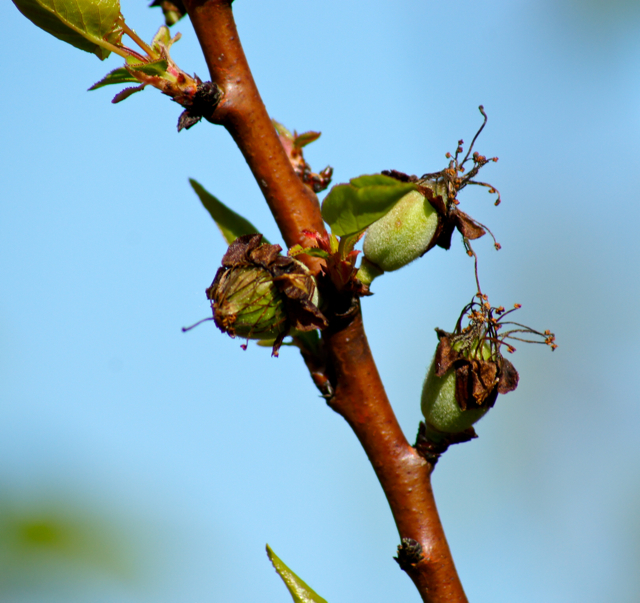
And by the end of March, small apricots were appearing. This is a critical time since the growing apricot has to shed the brown remains of the blossoms (called the jacket). Otherwise, the jacket can trap moisture and encourage a certain fungus to grow which damages the maturing apricot.
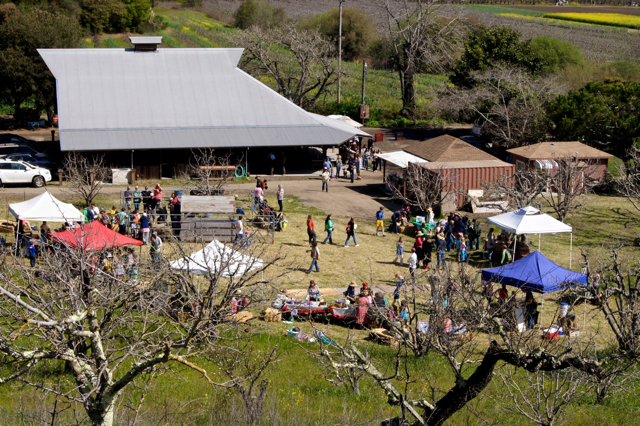
At the end of March we held our 4th Annual Sheep to Shawl event. The Lower Barn and surrounding area were prepped for throngs of people hoping to glimpse the sheep shearing, make some cool crafts, and eat some delicious food!

April is the beginning of Spring and our Main CSA Season. Green was the primary color as leaves burst forth on the trees.

As is typical, though, with our coastal weather, April began mostly foggy. The hens in one of our flocks were out and about enjoying the mild day. They had to be wary though …

… since the low fog kept a red-shouldered hawk roosting nearby, until the day cleared enough for it to look elsewhere for prey.
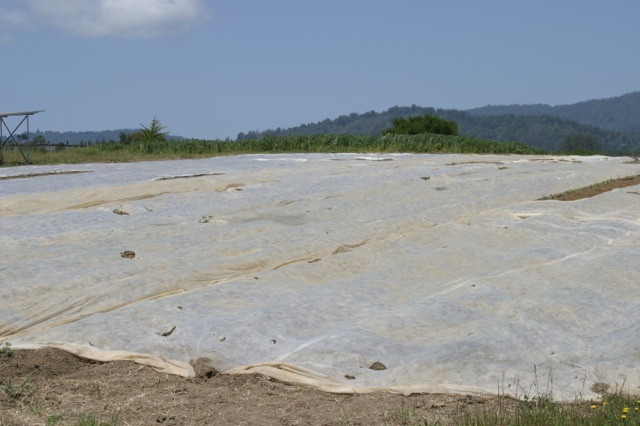
The end of April brought a touch of frost, and the need to cover recent dry-farmed tomato transplants and other vulnerable crops.
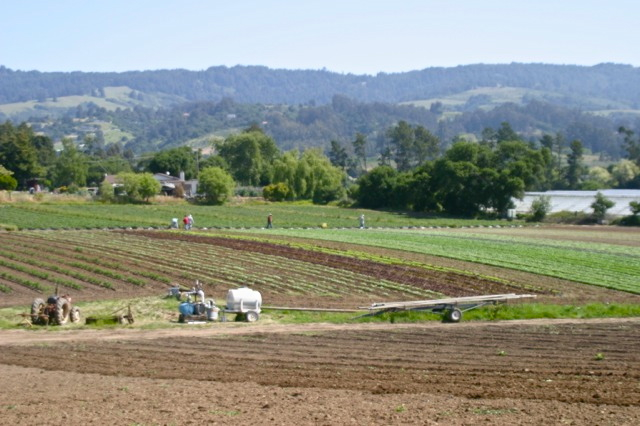
Though the year had begun wet, there hadn’t been much more rain and by May we were having to irrigate the fields and, unusually, many of the orchards. Pictured here is the main farm pump, and irrigation pipe ready to be placed in a recently planted field.
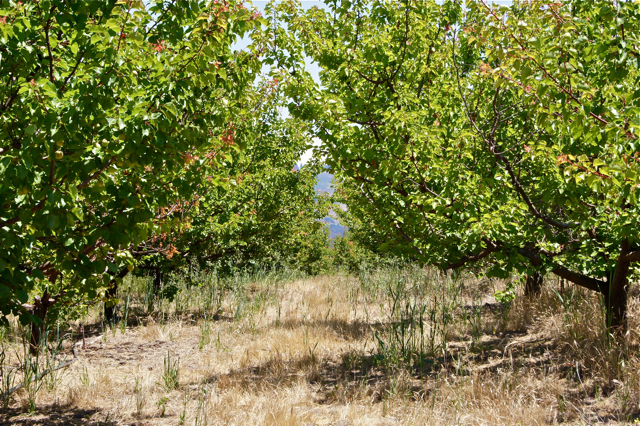
By the end of May the apricot leaves were looking hardier in preparation for summer. In contrast, the once green grass was already brown.

The apricots themselves were plumping up nicely. It was shaping up to be a bumper crop.

Meanwhile, along with many other things happening in the fields, it was time to thin the apples in order for the remaining ones to reach a large enough size. This bunch would be thinned down to two or three.
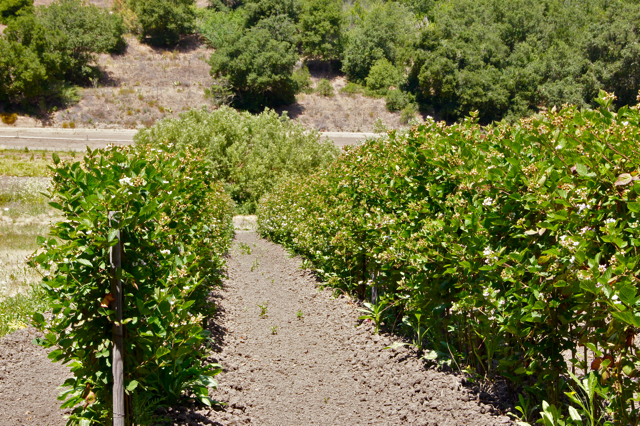
By the end of May, the blackberry vines were covered in blossoms.

Blackberry blossoms are a wonderful combination of white and pinkish purple. Looking almost tie-dyed.

June is the month when certain field crops, like crucifers, are tapering off and fruit, like the Santa Rosa plums pictured here, are ripening. It’s a transition time from Spring to Summer.

Our 18th annual Solstice Celebration was alive with joy and excitement. It was probably one of the best attended, and many visitors could be spotted harvesting strawberries from our Discovery Program garden prior to the evening potluck and bonfire.

The end of June was all about the Blenheim apricots. As we’d hoped, it was a bumper crop and we were able to hold a U-harvest day for CSA members to come and share in the bounty.

In July, the raspberry field in the middle-left of the picture looked very different from what it looked like in the pictures above from March. Leafy and green, the vines were now producing berries. More raspberry vines can be seen in the upper right corner.

As much as farmers do their best to keep crop production consistent, every year still brings its own differences. While the raspberries were wonderful, due to unfavorable weather conditions there weren’t as many this past summer as there have been in previous ones.

It was an abundant summer for blackberries, though, which stepped in to fill the gap left by the smaller raspberry harvests.

The Farm also serves as a classroom, and this past summer it hosted a teen program by Food,What?! The help could not have been more appreciated as the season approached its peak.
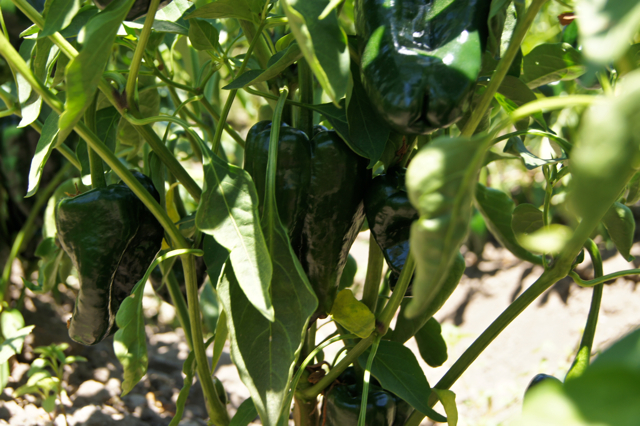
The end of July brought consistently warm days, and heat loving crops like these Poblano (often called, Pasilla) peppers sized up nicely. It was a very active time on the farm, with crop variety increasing almost daily.
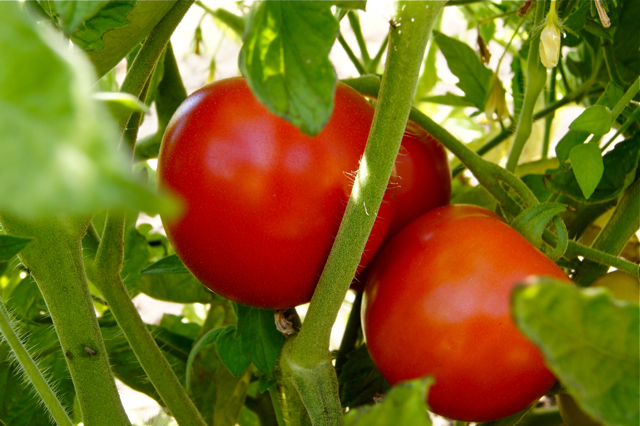
The first week of August brought a field visit from County Supervisor Kaputt, and it also brought the first dry-farmed tomatoes.

The summer squash field above was an abundant producer during August. The pickling cucumbers were in a nearby field.

While August crops were maturing in the fields, seedlings were being started in the greenhouse to stay on the planting schedule so there would be veggies to harvest in the upcoming months.

At the end of August, it was time to invite our community to the Farm for the summer’s first dry-farmed tomato u-harvest. We had a couple more scheduled u-harvest days, and the community field was open on Saturdays for harvesting all the way through October.
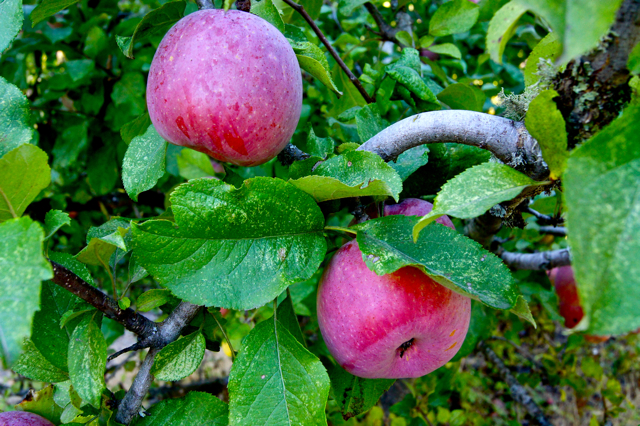
Tended to all year long, some apples were ready to harvest at the end of August while the majority of the apple varieties grown on the Farm, like these Fujis, were ready sometime during September and October.
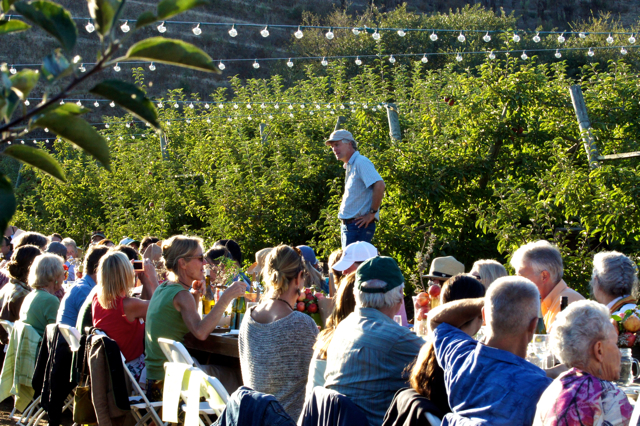
The Farm’s annual fundraiser for its Discovery Program was held in mid-September. The event, Slice, celebrated the apple harvest and was a great success, exceeding the year’s fundraising goal.

It rained a little, just before the Equinox. Not enough to make a difference in whether we needed to irrigate or not (we still did), yet it washed the dust off everything for the change of the season.

October was ushered in by the harvesting of our pumpkin patch, reminding us we needed to prepare for our Fall Harvest Festival at the end of the month.

Like June, October is another transition month. There was still a large variety of crops available or becoming ready, like this Romanesco cauliflower which creates a nest of leaves in which the head will mature.
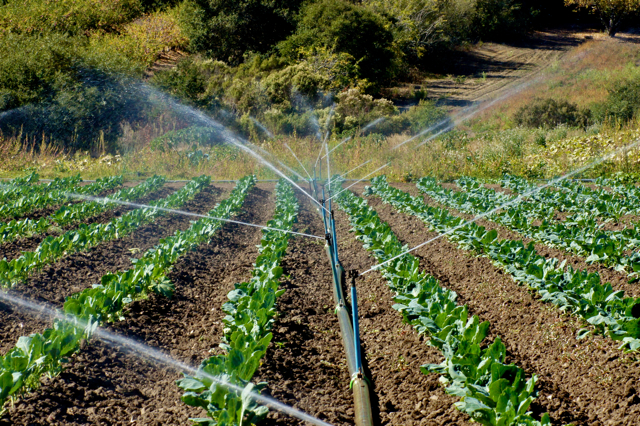
With no rain predicted in October, we were still irrigating fields like this one of Romanesco. This is the field that summer squash was growing in during August. Just beyond is the cucumber field, now covered in weeds and waiting to be plowed and planted with lettuce seedlings.
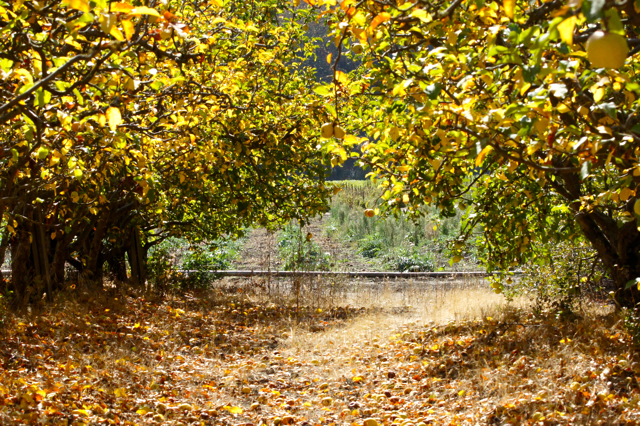
The angle of sunlight increases after the Equinox, and it takes on a golden tinge that triggers a response in the leaves of trees like these apples, causing them to yellow and fall.
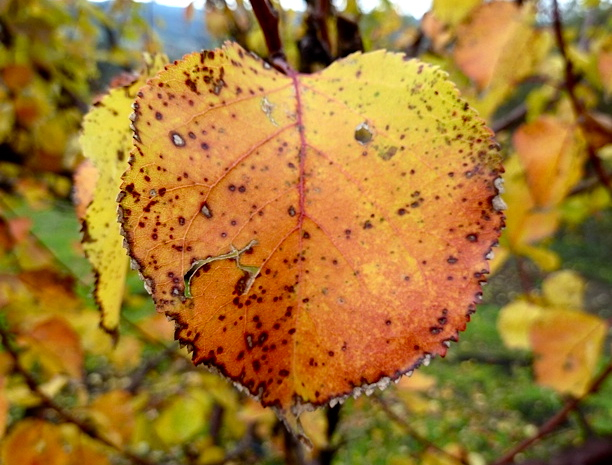
The Farm’s Main CSA Season ended in mid-November. Plant growth was slowing as colder days arrived with the approach of winter, and the fruit trees entered their period of dormancy. We began now to look to the beginning of our Winter Season at the end of the month, and further ahead to our next Main Season.
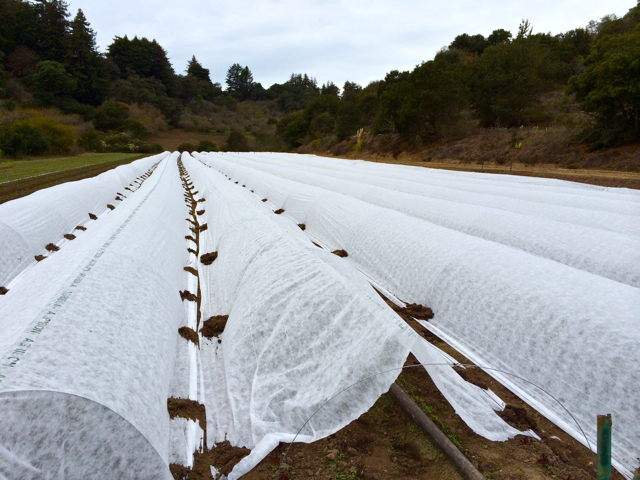
Reminiscent of the end of April, frost was predicted at the beginning of December. Once again, delicate crops like the lettuce in the field above were covered to protect them from frost damage.
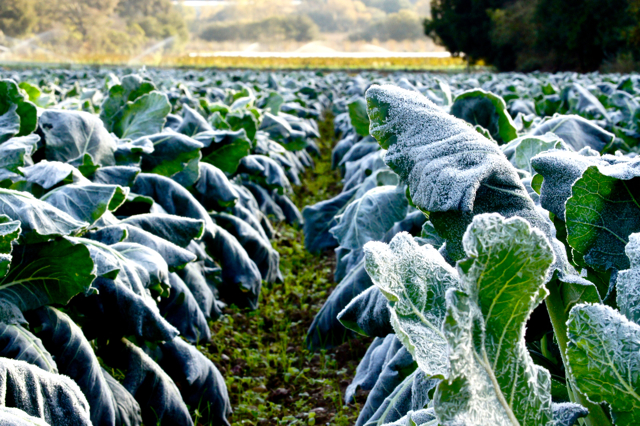
April’s frost was light and quick. December’s was heavy and occurred on a number of nights in a row. This is the field of Romanesco that was being irrigated in October. With growth slowed, the heads may not be ready to harvest until late January or early February.
This has been just one year in the life of Live Earth Farm. We want to thank all those who have participated in our Community Supported Agriculture program over the past 18 years. The Farm would not exist without the support of its community. As the Farm begins its 19th growing season, all of us here are dedicated to continuing to provide our community with the best organic produce possible, and to maintain the connection made between you and the source of your food.
[button link=”http://liveearthfarm.net/?p=47373″]About our CSA Program[/button]
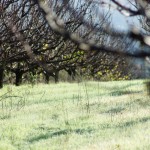 Winter on the Farm – Dec 2012
Winter on the Farm – Dec 2012
Our CSA program is on its 4-week 2012-13 Winter Delivery Break – while there may be no veggie boxes for a few weeks things are still (quietly) happening in the fields, as some plants bolt forth and others go into retreat. Here are some pictures from around the farm for you to enjoy.
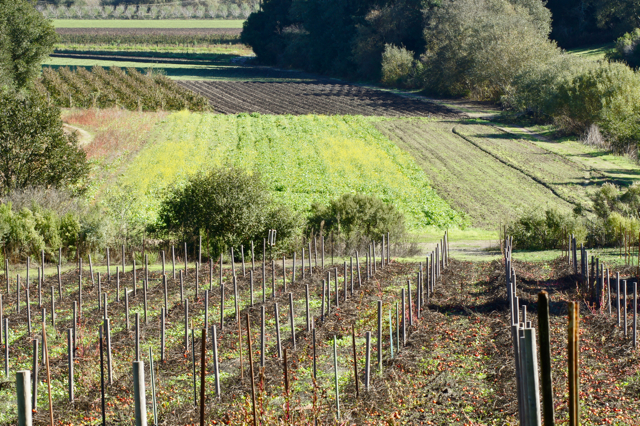
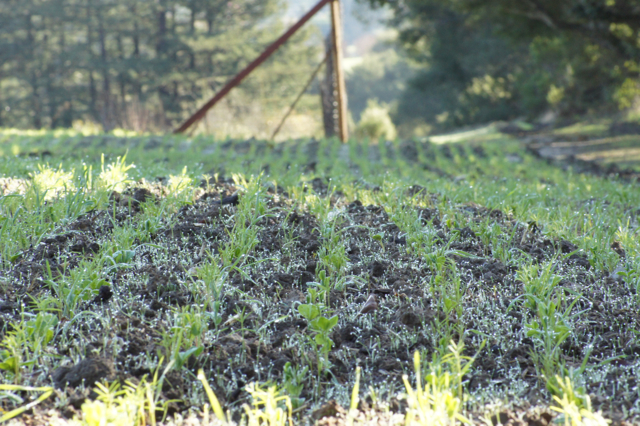
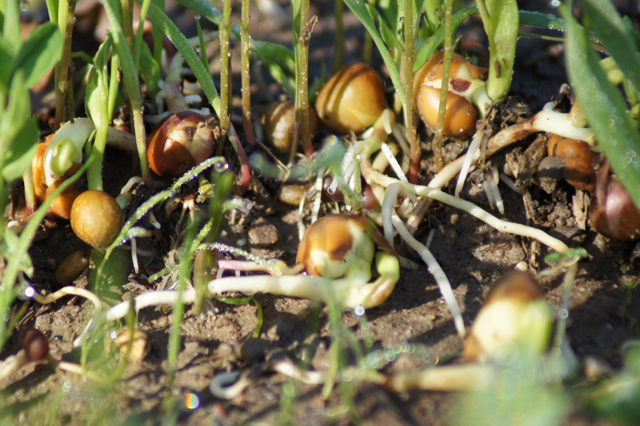
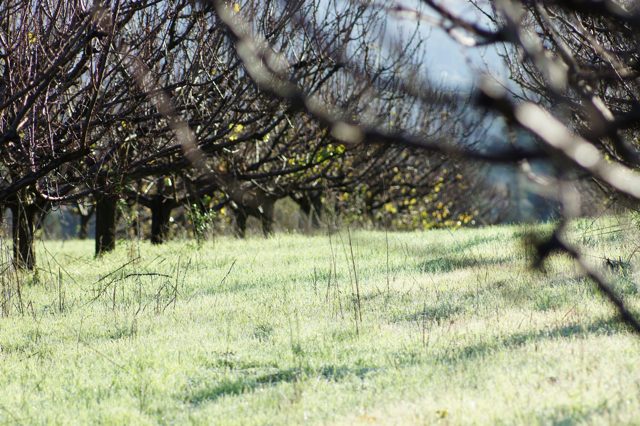
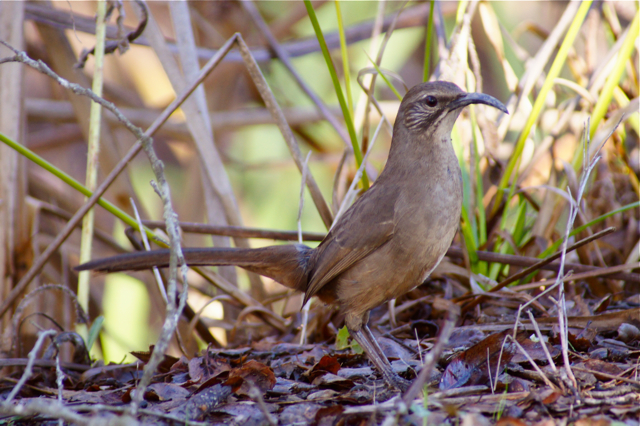
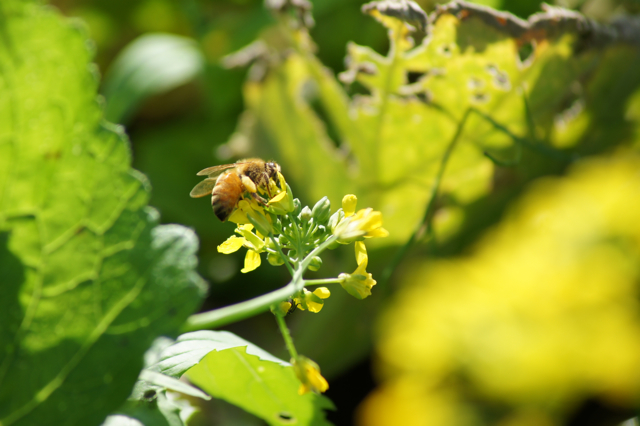
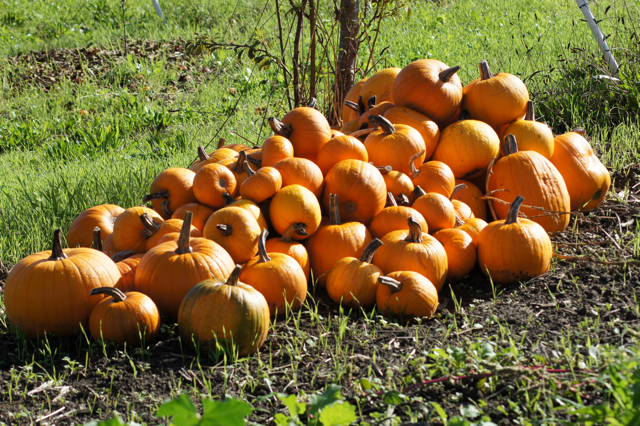

Taylor’s Crop & Field Notes:
The farm is particularly alive and green right now, thanks to that lovely warm rain we had a few weekends ago, and though it may still technically be winter the tempo these past few weeks is definitely starting to pick back up with the fields and orchards awakening early from the unseasonably warm weather.
We have large blocks of Romanesco cauliflower, rainbow chard, green garlic, and crunchy carrots coming on strong. I can’t believe it, but the early Chandler strawberries are not far off. The apricot branches are swelling – ready to burst into life in the next couple weeks. The tractors are working hard to prep fresh new beds for spring crops, and we are direct sowing seeds of spinach, radishes and various varieties of mustard greens.
We are all trying to relish these last few weeks of winter around the farm before things launch back into high gear for the start of main season CSA deliveries in April. Weekly restaurant, retail and wholesale deliveries have been on hiatus, and will begin again the first week of March.
During the seasonal CSA delivery break between winter and main seasons, we welcome you to come stock up on plenty of produce at one of the 3 year-round markets we attend: Santa Cruz Downtown on Wednesday afternoons; West Side Santa Cruz Saturday mornings; or Los Gatos on Sunday mornings.
The main CSA season is just around the corner…and it’s shaping up to be a great year ahead.

A rainbow of winter veggies at one of our Farmers Market stands.
Laura’s news from the greenhouse:
The warm weather we’ve been experiencing over the past couple of weeks has really helped speed things along in our greenhouse. Many of the seedlings for our staple crops (chard, kale, lettuce) are already being planted out into the field, and even the first of our spring specialty crops (summer squash and onions) are beginning to poke their heads out of their trays.
We’ve been embarking on a number of improvement projects to our greenhouse area as well, with a thorough cleaning of all our equipment, additional irrigation, as well as building some new structures to help improve the efficiency of work-flow with our vacuum seeder. We’re also trialing some new varieties of seeds, so keep your eyes peeled for things you may not have seen from us before. Good things lie ahead for us this season!
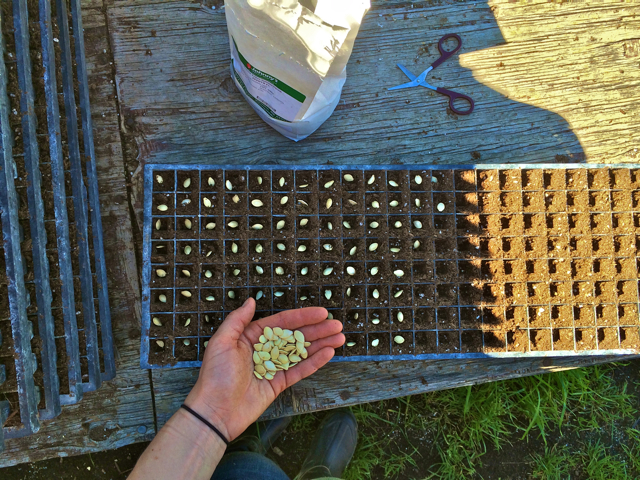
Sowing summer squash seeds.
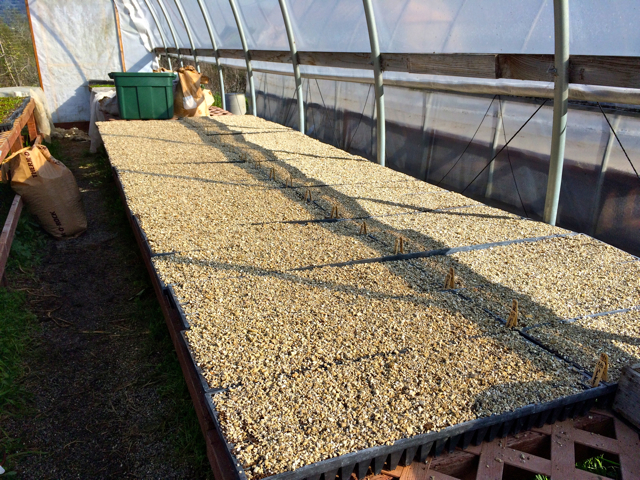
Freshly seeded trays topped off with vermiculite to help retain moisture and improve germination.
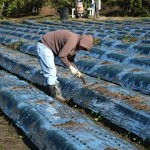 Planting and Planning for 2015
Planting and Planning for 2015
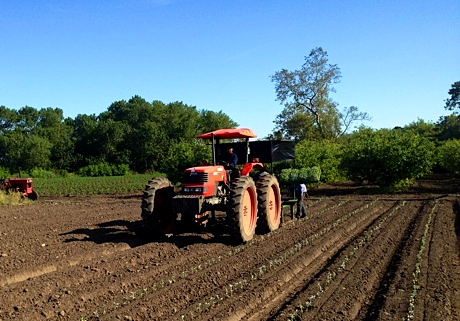 With only 5 weeks left, our 2014 CSA Season is quickly drawing to a close, and with impending rains (we hope soon) the Farm is in transition mode.
With only 5 weeks left, our 2014 CSA Season is quickly drawing to a close, and with impending rains (we hope soon) the Farm is in transition mode.
Tuesday, in anticipation of Wednesday night’s rain, the farm was abuzz with activity. By 7 o’clock in the morning our “Mudder” (high clearance tractor) was out in the field, Juan and Clemente sowing a large block of carrots, cilantro and spring onions. With shorter days and colder weather ahead of us, these seeds will take twice as long to develop into a harvestable crop – I expect January or February of 2015.
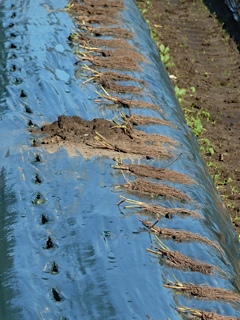
Bareroot strawberry starts waiting to be planted.
As soon as the tractor was freed up from doing the field sowing, Clemente and his team hitched up the transplanter and headed out to plant an acre of mixed brassicas (kale, broccoli, cabbage and cauliflower). By mid afternoon, most of the crew was busy packing CSA shares in the barn, however when the wind picked up and rain clouds started moving in a group of us headed out with the tractors to get the butternut squash, curing in the field, loaded into bins and hauled off into storage. We had just enough time to get it all done before dark–always a good feeling to know the Winter Squash is dry and safe for the winter.
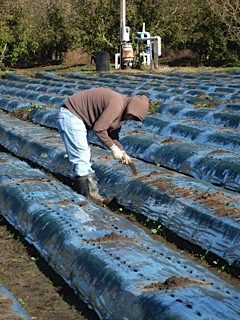
Planting strawberry starts is a delicate task.
The last couple of weeks a lot of energy and attention has gone into preparing the strawberry beds where next seasons crop will be planted. Not a moment too soon since the nursery called to pick up the first 15,000 strawberry starts. The Chandlers are always the first ones and need to be planted right away. It is our earliest variety and we can, under favorable weather conditions, start picking ripe berries as early as March. In addition to strawberries, other popular spring crops we need to plant now are green garlic, fava beans, Brussels sprouts and onions. To ensure a steady harvest during the winter we’ve also been sowing and transplanting hardy wintercrops such as parsnips, rutabagas, cabbage, turnips, broccoli, and leeks. Less winter hardy crops such as all the salad greens will be grown under protective row covers and hoop structures.

Protective row covers keep less hardy crops from getting frost-bit.
 Dry-Farming – Better Flavor while Conserving Water
Dry-Farming – Better Flavor while Conserving Water
The waiting is over, our dry-farmed tomatoes will be in everyone’s share this week, about 2 weeks earlier than last year. If only we could dry-farm more of our crops we might not be so worried about water shortages during this current drought cycle.

Before the rise of dams and aquifer pumping, much of the American West practiced dry-farming. Today only a handful of perennial crops such as Olives, Grapes, and Apples are still dry-farmed on a limited scale. Along some favorable coastal microclimates farms like ours dry-farm tomatoes, potatoes, and sometimes winter squash. What’s special about dry farming is the ability to grow a crop by only utilizing the residual moisture in the soil accumulated during the rainy season.
This year the first field of Early Girl tomatoes was planted just before the last rains of the season fell back in March. Since then, 4 months now, no additional water has been applied to the crop. Key to dry farming successfully is to prevent soil moisture evaporation. This is done by tilling the surface of the soil, creating a layer of dry mulch that effectively traps moisture in the clay-rich subsoil.
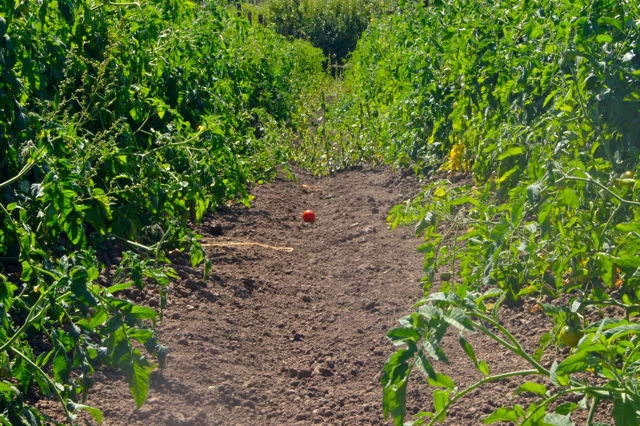
The “Early Girl” is the tomato variety of choice for dry farming. It has a vigorous rootsystem that can tap deep into the subsoil.Dry-farming tomatoes is a technique perfected a couple of decades ago by Molino Creek, a farming cooperative situated in the coastal hills above Davenport in northern Santa Cruz County. We are fortunate to enjoy a similar microclimate here in the foothills of the Santa Cruz Mountains in the southern part of the county. Under optimum conditions the plants, although stressed from a lack of water, will stay healthy enough to yield tomatoes bursting with flavor.
Although Early Girl’s were bred in France, tomatoes find their origin in the jungles of Central and South America. The Mayans called it “xtomatl” hence the name tomato. When the Spanish brought the first tomato to Europe the Church condemned eating tomatoes as a scandalous and sinful indulgence. The French on the other hand admired its sensuous appearance and were enticed by it, believing that the red fruit had aphrodisiac powers, and so called it “pomme d’amour” or love apple. Today, we probably couldn’t imagine anything more scandalous than not having tomatoes as part of our diet.

Potatoes are one of my favorite crops to grow, and probably had something to do with my decision to start farming. When I joined the Peace Corps in Western Samoa (South Pacific 1985-1988), I worked with farmers used to growing upland-taro to try to plant and experiment with different varieties of potatoes.
We successfully selected a few varieties that grew well, especially in fields at higher elevations where temperatures tended to be cooler. Many of the farmers were excited to sell them at local markets, where they sold as a specialty at a good price. Potatoes are native to the Andean mountains of Peru, Bolivia, and Ecuador, where several thousand varieties have been identified.

Current potato field pictured at the end of April.
Today potatoes are grown worldwide, cultivated everywhere from below sea level to 14,000 feet above. You may find it interesting that potatoes belong to the Nightshade family, same as your favorite tomatoes, peppers, and eggplants. Potatoes were once considered the poor man’s crop, and where often grown to protect against famine during times of war and grain crop failures. In some countries, such as Ireland, dependence on the potato grew until 1845, when the famous potato blight (Phytophtora Infestans) wiped out most of the crop and catalyzed a severe famine and massive immigration of Irish to the United States.

Here’s the field starting to be harvested this week.
Nutritionally, potatoes are an excellent source of complex carbohydrates and minerals, particularly potassium, provided the skin is consumed.
We are starting to harvest the earlier maturing Colorado Rose potatoes for our CSA shares this week. The tops are still green, but the tubers have sized up enough to start digging them. Over the next few months you will receive different varieties, both white and yellow fleshed, including Yellow Finn, Yukon Gold, and Fingerlings. Enjoy!

Buried treasure – Colorado Rose Potatoes

Potatoes are harvested using a “fork” to dig under the side of the row then lift and break up the soil, freeing the potatoes.
 About Kohlrabi
About Kohlrabi
 Kohlrabi is in the Brassica oleracea category. The part that is eaten is the stem, which swells into a globe, rather than the root. It can grow to the size of a grapefruit, but will tend to have a wooly interior, so it is far better harvested at half the size.
Kohlrabi is in the Brassica oleracea category. The part that is eaten is the stem, which swells into a globe, rather than the root. It can grow to the size of a grapefruit, but will tend to have a wooly interior, so it is far better harvested at half the size.
There are two varieties, green and purple, but both taste similar. They have a distinctive flavor, something of fresh water chestnuts with a touch of radish and celeriac. They make a marvelous foil for other flavors; sometimes fooling people into thinking they are artichoke hearts. Kohlrabi is rich in potassium, fiber, and vitamin C.
It is particularly good as a salad or in a platter of crudités when par-boiled. Slice it and simply simmer it for a few minutes, then leave in cold water for a while before draining and mixing with other vegetables.
Grated it can be lightly cooked, stir-fried in a little oil or butter with some mustard seeds to give it some spice. You can stuff it, or use it instead of potatoes in gratin dishes. It can also be used like cauliflower.
Kohlrabi Salad
Kohlrabi Gratin
Cream of Kohlrabi Soup
Sauteed Kohlrabi
Farmer Tom’s Mashed Kohlrabi
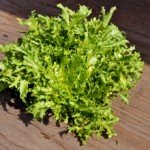 The Chicory Family
The Chicory Family

Frisee
Much more appreciated in Europe than in the United States, the chicory family is a large one. Belgian endive, curly endive (sometimes called frisee), escarole, and radicchio are all members. Each differs considerably in appearance, color, and to some extent flavor, although all share a slightly bitter taste, and most produce a root that can be roasted, ground, and combined with coffee to create the chicory coffee beloved in French/Creole cultures.
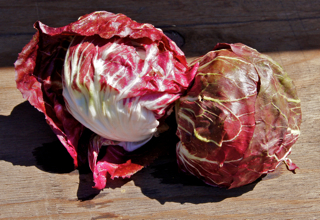
Radicchio
The chicory family is a wide and varied group that can be loose-leafed or tightly-headed, tapered or round, smooth-leaved or frilled. They are also brightly colored, ranging from the purest white and pale yellow to bright green or maroon.
All members of the chicory family are flavored for the bitterness that they all share, unlike lettuces, which are chosen for their delicacy. The chicories’ bite and texture combine nicely with richer ingredients in salads, like fruits, nuts, and sharp cheeses or smoked salmon, chicken or ham.

Escarole looks a bit like Romaine Lettuce.
Try chicories with the following additions: Fresh shell beans or fava beans, blanch until tender. Remember that adding vinegar or lemon juice will cut the bitterness of the choicories.
Braised Escarole with Garlic and Lemon
Apple Escarole Salad with Blue Cheese and Hazelnuts
Sauteed Escarole with White Bean Salad
Warm Salad with Frisee and Glazed Squash

